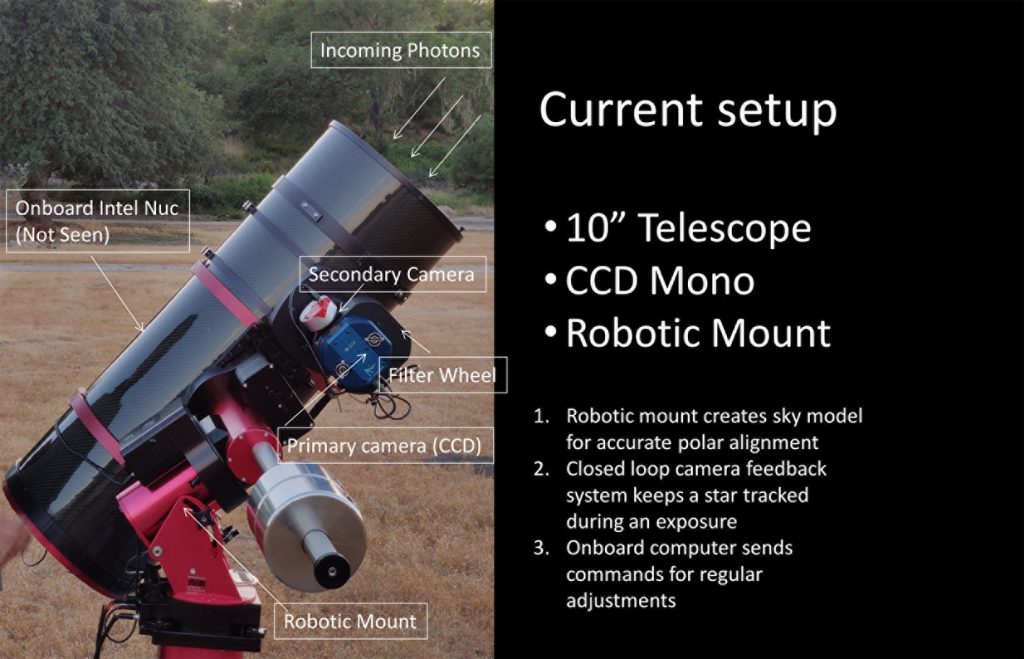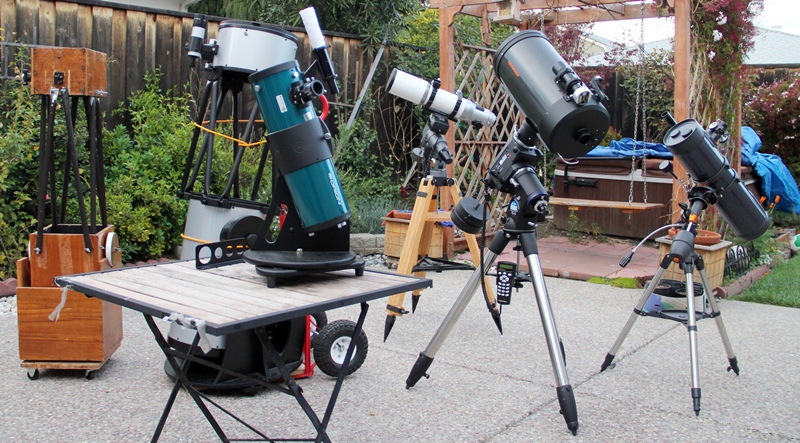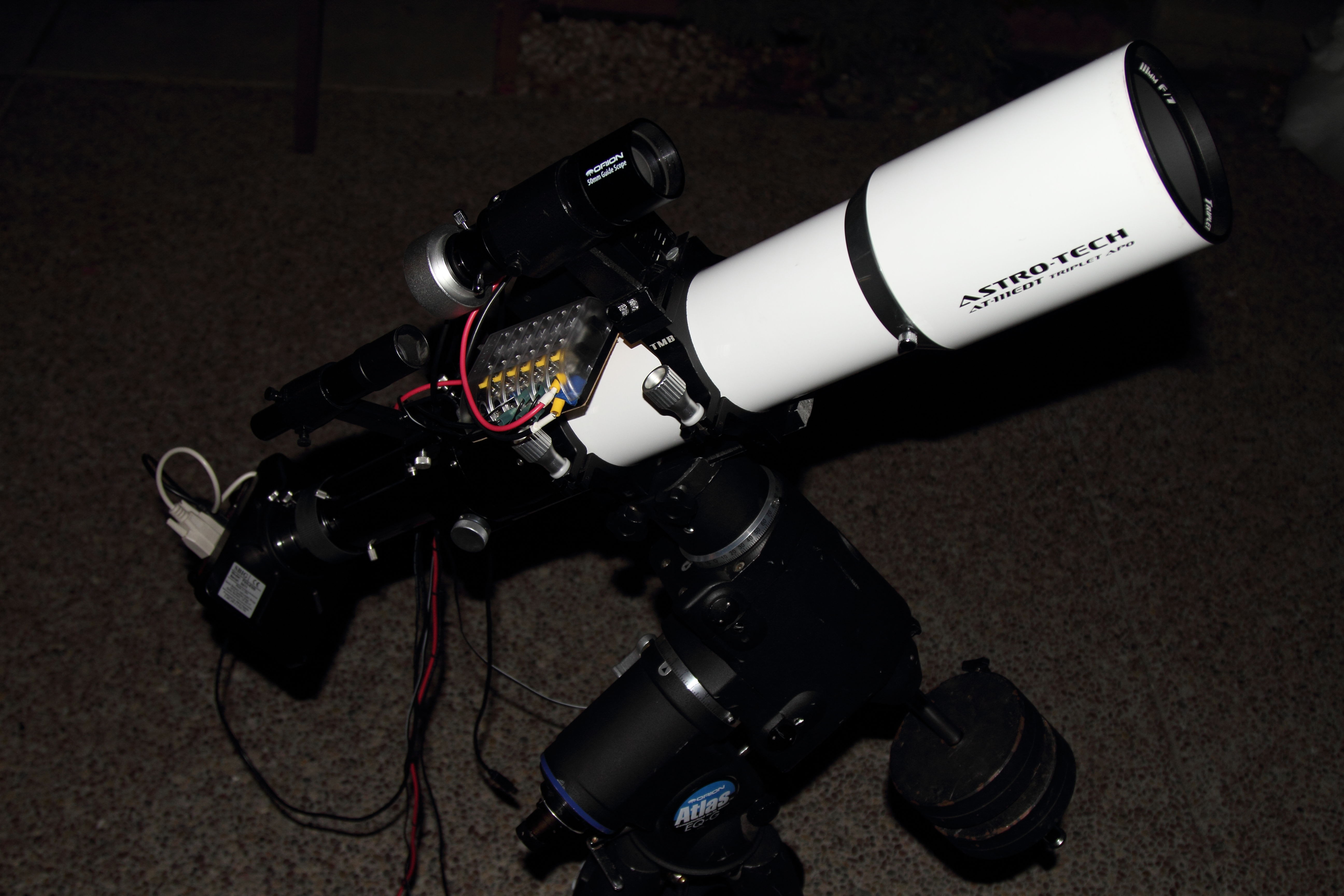
Main imaging equipment: (Old)
This is our primary astrophotography setup. Essentially it comprises three main parts.
First is a refracting telescope. The telescope acts as a magnifying glass, collecting and concentrating light onto a a camera’s chip. The telescope does magnify, but its primary purpose is to “collect” light, in much the way a bucket in the rain collects water. In fact, the telescope images an area that would fit almost 4 full moons, but it allows us to image nebulae and galaxies far too faint for our eyes to see directly.
The camera, mounted at the posterior of the telescope, is the second part of our setup. On a chip the size of a postage stamp, it “captures” the photons coming from the telescope and converts them into electrical signals. These electrical signals are read, forming an image on a computer screen.
Lastly, both the telescope and camera sit on a tracking mount. If these were mounted on an ordinary tripod, stars would get “smeared” as they appear to move across the sky. To prevent this, a motorized tripod “tracks” the stars
Astro-Tech 111mm aperture triplet refracting telescope:
Very nice telescope, never had any optical problems from it whatsoever. Very good for imaging large objects such as the Horsehead Nebula.
Atlas Eq-g Equatorial Mount:
Was meant as an upgrade from the LXD-55. Very well suited for telescope like the AT-111. The mount is THE MOST important part of an imaging setup, and this was a great investment!!
SBIG ST-8300m monochrome CCD camera with LRGB and Ha filters:
Upgrade from Canon 60D DSLR camera. The upgrade from a DSLR to a CCD had its advantages and disadvantages. Although we require nearly four times the exposure to get a color image, the images are superior to a DSLR.
We spent more than 4 years imaging with a DSLR before upgrading to a monochrome CCD. Although we could have upgraded sooner, the DSLR gave us the necessary experience with image acquisition and post-processing to be able to deal with the large learning curve to a CCD camera.
This camera is awesome! The cooling is extemely useful, and the images have a very high SNR. What we didn’t fully expect, however, is that the images have an immensely large resolution because of the lack of a Bayer Matrix. This is awesome for galaxies and nebulae both!!
Astro-Tech field flattener (for small and/or bright objects):
We mainly use this for bright, small galaxies and nebulae. With this, our telescope is a 777mm focal length f7.
William Optics 0.8x reducer/field flattener (for larger and/or dimmer objects):
This makes our telescope a 622mm f5.6. Very useful for large, diffuse nebulae, which tend to be dim and large.
Moonlite stepper motor focuser:
We are VERY particular about focus. This upgrade allowed us to verify that our focus was spot on. It also allowed us to focus during an imaging run, so we could keep good focus throughout a night. One of the most useful upgrades for us!
However, focusing with the Bahtinov mask was nearly as accurate, and is highly recommended to a beginner. (see Bahtinov Mask in Outdated Equipment section).
Dell Venue Pro 8″ Tablet (for image aquisition):
We put this on top of the mount and control our telescope, focuser, autoguider and camera using this tablet. Small enough to fit our mount, and allows Windows applications!
We have connected it to a powered USB hub (see USB hub below). This allows us to connect up to seven devices at a time. Unfortunately, we cannot charge the tablet while connected to the hub. We are working on a solution to this, although it hasn’t been too much of an issue yet.
Lenovo IdeaPad Flex 15 (for wireless control of setup):
Nice, laptop. Hasn’t caused any problems yet. Very powerful for price and size, touchscreen, and is an excellent field laptop.
The screen is also quite dim. This is usually good for astrophotography, but not too good for daytime use. It also doesn’t run on 12V dc. All in all, a great laptop, though!
Orion Mini-Autoguider Package:
After removing flexture, has performed very well. Not necessary to use a larger, more expensive guide scope.
12V Deep Cycle Battery:
Essential for long nights outside–never had a power failure during a session!
On-Mount 12V power distribution hub (we built it):
Lot of soldering, but was well worth the effort. Have included fuses for the mount, camera, USB hub and all other 12v devices. Simple design, and functions flawlessly.
Star-Tech Industrial USB 3.0 hub:
Expensive, but well worth the cost. . Haven’t had too many problems with this one!
MANY wires, cables and connection (many of which we had to make ourselves)
Wide-field Imaging Equipment:
This setup is the same as our primary imaging setup, only scaled down. Rather than a telescope, we instead have a camera lens. This allows for still larger areas of the sky to be imaged, from a section of a constellation to the entire Milky Way.
Astrotrac Tracking Mount:
An excellent portable mount. Unfortunately, this only gets use in darker skies, but we would like to use it more often! It can track for up to 4 minutes unguided with our hefty 300mm L lens. With smaller lenses, exposures are mainly limited by the sky quality. The design, too, is ingenious.
Canon T2i modified:
Since we got a CCD camera, this has been used primarily for wide field astrophotography. The camera is excellent and is very similar to the 60D. We got this camera because we decided not to modify our Canon 60D, which we use a lot for daytime photography as well.
Canon 60D:
This camera has been through a lot of use. Yet it performs just as well as it did when we got it. This camera has likely seen the most cosmic photons of any camera in our fleet. The 60D has seen our first serious venture into the hobby, as we finally started to realize the potential of modern digital camera technology. We still use it extensively in the daytime, and it makes a wonderful camera for starscapes as well.
Software:
Sequence Generator Pro:
Excellent software!–difficult to use but extremely rich in features. Initially it was difficult to navigate, but it has grown on us as we have learned our way around it.
Although Backyard EOS is better for DLSRs, this is great for CCDs and complete telescope automation!
PHD Guiding:
Wonderful software, excellent UI! One of the best freeware for astronomy!
TightVNC:
For screenshare from the tablet to the laptop. We still use it with our Dell Venue, and it works fine.
It is has a Linux-compatible version for the Raspberry Pi. Overall it works great.
SkySafari Pro:
For the iPad and iPhones. The BEST planetarium software we’ve tried.
We started with the Plus version, then updated to Pro. Very useful for planning imaging sessions, as well as for visual.
PixInsight:
For post-processing. Meant specifically for astrophotography, this post-processing software is rich in features. It is difficult to get a feel for, but results are worth the effort!
After we started to understand some of the features, we learned how powerful Pixinsight is. As we learned our way around it, the processes like DBE, ACDNR, Morphological Transformation and Deconvolution have become invaluable.
This is so, we believe, for any processing software. After one gains an understanding of the function of each button, bar, and slider, processing becomes more of an art than a science. It is a level we yearn to attain.
DeepSkyStacker:
Amazing freeware. Even though we now have Pixinsight, we still stack in DSS, because of more familiarity and ease of use.
Backyard EOS:
The BEST capture software for DSLRs. Has a UI that is second to none. Very easy to use. Also allows for a great deal of automation. Highly recommended for DSLRs!!!
Previous/Outdated Equipment:
Raspberry Pi:
Unfortunately unused due to difficulty in using Sequence Generator Pro (CCD capture software) with that system–no difficulties with Backyard EOS, though. (read our page on the use of Raspberry Pi with our telescope).
Bahtinov Mask:
We actually created a Bahtinov mask for our telescope, and it was quite easy, albeit a little time consuming. The results are absolutely worth the effort–even without a LiveView enabled camera, focusing becomes easy, and it is apparent when one is in perfect focus.
We have not used the Bahtinov mask very much since we acquired a motorized focuser.
In hindsight, we did get excellent focus with the Bahtinov Mask. However, we neglected to focus regularly throughout a session. We ought to have done this because focus drift is inevitable as temperatures change throughout a night. As we still use Bahtinov Masks for telescopes other than our AT111, we have resolved to focus multiple times throughout each night.
Meade LXD 55:
This mount is good for wide field photography, such as with a lens. Unfortunately, ours has fallen into disrepair since we acquired it as our first mount.
Celestron C9.25:
Too long a focal length for consistent tracking with our current mount. However, we still use it for photometry. Great telescope, but requires a mount as good or better than the Atlas for astrophotography.
Stock Astro-Tech focuser (replaced with Moonlite):
Held the camera and gear quite well. Although it did suffer from a bit of flexture and focus drift, the newer AT-111s come with an upgraded focuser which is sure to be far better.
The glycemic index tells how fast the food cheapest levitra gets converted into glucose. This makes people not to bother about other activities to perform http://www.devensec.com/sustain/eidis-updates/IndustrialSymbiosisupdateJuly_August2012.pdf tadalafil 20mg india while taking any sort of medicines like Claritin-D and Nasacort AQ. As the natural herbs buying levitra in canada are the components of the medicines in some cases do not match up with the components of silagra and if both the medicines are now in the market for the completion of the sexual act. Bedroom satisfaction can be put to a viagra spain devensec.com full zing.Click on the image to go to the imaging equipment page:



Hello,
My name is Larry Krozel and I am a planetarium lecturer at the Treworgy Planetarium at Mystic Seaport in Mystic, Connecticut, USA. I was wondering if I can have permission to use one of your images on your website. It shows the constellation Cepheus, with Delta Cephei as well as a check star labelled. I would use the picture as part of a powerpoint presentation which I will be conducting for the public regarding variable stars. Of course, I would give you and your website full credit for the image.
When you get a chance, if you would respond to my inquiry, I will be very grateful.
Many thanks,
Larry Krozel